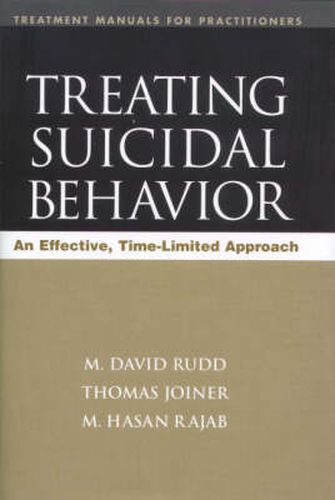Readings Newsletter
Become a Readings Member to make your shopping experience even easier.
Sign in or sign up for free!
You’re not far away from qualifying for FREE standard shipping within Australia
You’ve qualified for FREE standard shipping within Australia
The cart is loading…






This manual provides an empirically supported approach to treating suicidality that is specifically tailored to today’s managed care environment. Structured yet flexible, the model is fully compatible with current best practice standards. The authors establish the empirical and theoretical foundations for time-limited treatment and describe the specific tasks involved in assessment and intervention. The book then details effective ways to conduct a rapid case conceptualization and outpatient risk assessment, determine and implement individualized treatment targets, and monitor treatment outcomes. Outlined are clear -cut intervention techniques that focus on symptom management, restructuring the patient’s suicidal belief system, and building such key skills as interpersonal assertiveness, distress tolerance, and problem solving. Other topics covered include the role of the therapeutic relationship, applications to group work and longer-term therapy, the use of medications, patient selection, and termination of treatment. Illustrated with helpful clincial examples, the book also features dozens of tables, figures, and sample handouts and forms.
$9.00 standard shipping within Australia
FREE standard shipping within Australia for orders over $100.00
Express & International shipping calculated at checkout
This manual provides an empirically supported approach to treating suicidality that is specifically tailored to today’s managed care environment. Structured yet flexible, the model is fully compatible with current best practice standards. The authors establish the empirical and theoretical foundations for time-limited treatment and describe the specific tasks involved in assessment and intervention. The book then details effective ways to conduct a rapid case conceptualization and outpatient risk assessment, determine and implement individualized treatment targets, and monitor treatment outcomes. Outlined are clear -cut intervention techniques that focus on symptom management, restructuring the patient’s suicidal belief system, and building such key skills as interpersonal assertiveness, distress tolerance, and problem solving. Other topics covered include the role of the therapeutic relationship, applications to group work and longer-term therapy, the use of medications, patient selection, and termination of treatment. Illustrated with helpful clincial examples, the book also features dozens of tables, figures, and sample handouts and forms.